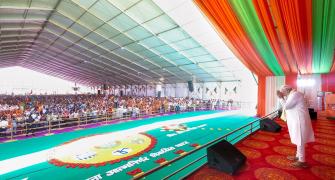The labour force fell from 43.97 crore in 2016-17 to 42.61 crore in 2017-18
Illustration: Uttam Ghosh/Rediff.com

Fiscal 2017-18 was a difficult year for the Indian economy.
Real GVA growth slowed down to 6.5 per cent compared to 7.1 per cent in the previous year.
This was also the worst year for growth since 2013-14.
The investment ratio, at 28.5 per cent was the lowest since 2011-12. It has been falling relentlessly indicating declining investment demand in the country.
This fall in investment demand is also captured by CMIE's CapEx database.
Announcement of new investment projects declined by 38.4 per cent and completion of new projects declined by 26.8 per cent in 2017-18 compared to the previous year.
Foreign direct investments were down by 15 per cent.
This stress seen in the economy in official and private data is also reflected in CMIE's employment and unemployment statistics.
The number of persons employed in 2017-18 was 40.62 crore. This was 0.1 per cent or 0.465 million lower than the 40.67 crore employed in 2016-17.
This is an extremely small fall in employment. Given that in such estimations which are based on large sample surveys there is always a small margin of error it would be safe to say that there was no fall in employment.
In technical terms we would say that the measured fall is not significantly different from zero fall if we adjust for the possible unavoidable errors in measurement.
On the flip side we may also infer that there was also no growth in employment in 2017-18.
Employment must grow because as population grows, the number of people seeking employment also increases.
If employment is stagnant while the population keeps growing, the employment rate (which is the proportion of working-age population that is employed) declines.
This is what happened in 2017-18 when the employment rate fell to 41.45 per cent compared to 42.59 per cent in 2016-17.
Interestingly, while the employment rate declined, the unemployment rate also declined (from 7.51 per cent in 2016-17 to 4.66 per cent).
While the former reflects an economy in poor health, the latter indicates good health. How are both possible simultaneously?
The problem is with the unemployment rate which turned unreliable after demonetisation when a large number of unemployed persons stopped looking for jobs.
These were mostly youngsters, many of them were uneducated and were women.
Why did they stop looking for jobs is a different matter. The relevant and important observation is that they stopped looking for jobs.
As these unemployed persons stopped looking for jobs, they were not called unemployed any more.
They hadn't found jobs so, they were not classified as employed either. They simply exited the labour force.
This led to shrinking of labour force and a misleading fall in the unemployment rate.
The labour force fell from 439.7 million in 2016-17 to 426.1 million in 2017-18.
The labour force participation rate (which expresses the labour force as a per cent of the working-age population) fell from 46.1 per cent to 43.5 per cent.
It is the labour force participation rate that is a better measure of the labour market conditions in India.
It is not good if the number of people willing to work declines. It is not good if an increasing proportion of the working-age population express no interest in working. But, this is what happened in 2017-18.
The ripple-effects of the twin shocks of demonetisation and GST continue to impact the economy.
Consumer demand is muted. Persistent low food inflation is a possible reflection of this. Low investment demand is a clear reflection of poor consumer demand.
Capacity utilisation is still low. In such conditions, the stagnation we observe in employment is understandable.
The first quarter of 2018-19 turned worse. Employment fell to 40.19 crore, labour participation rate fell to 42.7 per cent and the employment rate fell to 40.4 per cent.
All these indicators are lower than their corresponding values during a year-ago quarter and during the preceding quarter.
Interestingly, the unemployment rate during the first quarter of 2018-19 at 5.5 per cent is higher than the 4 per cent it had penciled in the first quarter of 2017-18.
Implicitly, people are coming back to the labour force and not finding jobs.
But, this influx into the labour market is not enough yet to raise the labour participation rate.
Does this imply a turnaround? Not yet. If 2017-18 was as difficult year, 2018-19 is a challenging year already.
Rains have been somewhat erratic, kharif sowing is 10 per cent below last year's, crude oil prices have risen, FPIs are exiting, the rupee is weak, the balance of payments is vulnerable and the fisc is in danger of running amok.
These are not the best times to expect private entrepreneurs to invest and so not the best time to find new jobs.










